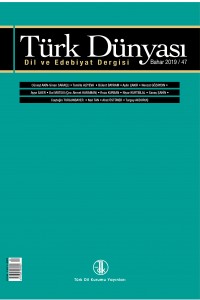Öz
For the historical analysis of the pre-modern Turfan society, it is an
indispensable task to identify the toponyms attested in the Turfan texts in
various languages. According to the Chinese historical sources, “twenty-
two cities” existed in the Turfan Basin under the ( 高昌 ) Gaochang
Kingdom of ( 麴 ) Qu Family in 640 CE, when it was conquered by the
Tang dynasty. Several names of the “twenty-two cities” are recorded in
the Chinese chronicles as well as in the Turfan Chinese manuscripts, and
Turfan scholars have conducted a series of geo-historical surveys to identify
them in comparison with the toponyms in the Chinese records of the
Ming and Qing dynasties and the modern Uigur ones. Since the latter half
of the 9th century the Turfan Basin was brought under the direct rule of
the West-Uigur Kingdom, whose dominion was designated also as “twenty-
two cities of the nation of Qočo” (qočo ulus ikii otuz baliq) in one of
the Old Uigur Manichaean texts: After their submission to the Činggisid
Mongol Empire at the early 13th century, the number of the cities ruled
by the Uigur king iduq-qut is once mentioned as twenty-four. Among the
Old Uigur texts from the 9th–14th centuries, we can find the toponyms
identified to the modern Turfan oases. In this article, the cities of Çïqtïn,
Puçang, Soim, Qongsïr (Qongḍsïr), Limçin, Singging (Singing), Nižüng
(Nişüng ~ Lişüng), Nampï (Lampï) and Yimşi (Yemşi) were examined.
Anahtar Kelimeler
Kaynakça
- Abe, T. 安部健夫 (1955). 西ウイグル國史の研究 Historical Study of the West Uighur Kingdom. Kyoto.
- Arakawa, M. 荒川正晴 (1986). “麴氏高昌國の郡縣制の性格をめぐって [On the Character of the Chun-hsien System in the Kingdom of Kao-ch’ang under the Rule of the Ch’u Familiy]”. 史學雜誌 Shigaku zasshi 95-3, 37-74.
- Arakawa, M. 荒川正晴 (1997). “唐代トゥルファン高昌城周邊の水利開發と非漢 人住民 [Development of Irrigation and Non-Chinese Population around the city of Gaochang in Turfan Basin under Tang Rule]”. T. Moriyasu (ed.), 近世・近代中國 および周邊地域における諸民族の移動と地域開發 Migration of Peoples and Community Development in Pre-modern and Modern China and in Surrounding Areas, Osaka: 1-48.
- Bailey, H. W. (1982). The Culture of the Sakas in Ancient Iranian Khotan. New York. BT VIII = (1977). Kara, G. / Zieme, P. Die uigurische Übersetzungen des Guruyogas “Tiefer Weg” von Sa-skya Paṇḍita und der Mañjuśrīnāmaṃgīti (Berliner Turfantexte VIII). Berlin.
- BT XIII = (1985). Zieme, P. Buddhistische Stabreimdichtungen der Uiguren (Berliner Turfantexte XIII). Berlin.
- BT XVI = (1993). Cerensodnom, D. / Taube, M. Die Mongolica der Berliner Turfansammlung (Berliner Turfantexte XVI). Berlin.
- Cen, Z. 岑仲勉 (1945). 吐魯番一帶漢回地名對證 “[Identification of the Chinese and Uigur Toponyms in the Turfan Region]”. 中央研究院歴史語言集刊 Zhongyang yanjiuyuan lishi yuyuan jikan 12.
- Cen, Z. 岑仲勉 (1962). 中外史地考證 Zhongwai shidi kaozheng, Vol. II, Beijing. Chen, G. 陳國燦 / Liu, Y. 劉永増 (1997). 日本寧樂美術館藏吐魯番文書 Turfan Manuscripts Preserved at Neiraku Museum, Japonya. Beijing.
- Chotscho = (1913). Le Coq, A von. Chotscho. Berlin.
- Clark, L. V. (1975a). Introduction to the Uyghur Civil Documents of East Turkestan (13th– 14th cc.). Indiana Üniversitesi Doktora Tezi.
- Clark, L. V. (1975b). “On a Mongol Decree of Yisün Temür (1339)”. Central Asiatic Journal 19-3, 194-198.
Öz
Anahtar Kelimeler
Turfan Havzası eski Uygur yer adları eski Uygurca yer adları
Kaynakça
- Abe, T. 安部健夫 (1955). 西ウイグル國史の研究 Historical Study of the West Uighur Kingdom. Kyoto.
- Arakawa, M. 荒川正晴 (1986). “麴氏高昌國の郡縣制の性格をめぐって [On the Character of the Chun-hsien System in the Kingdom of Kao-ch’ang under the Rule of the Ch’u Familiy]”. 史學雜誌 Shigaku zasshi 95-3, 37-74.
- Arakawa, M. 荒川正晴 (1997). “唐代トゥルファン高昌城周邊の水利開發と非漢 人住民 [Development of Irrigation and Non-Chinese Population around the city of Gaochang in Turfan Basin under Tang Rule]”. T. Moriyasu (ed.), 近世・近代中國 および周邊地域における諸民族の移動と地域開發 Migration of Peoples and Community Development in Pre-modern and Modern China and in Surrounding Areas, Osaka: 1-48.
- Bailey, H. W. (1982). The Culture of the Sakas in Ancient Iranian Khotan. New York. BT VIII = (1977). Kara, G. / Zieme, P. Die uigurische Übersetzungen des Guruyogas “Tiefer Weg” von Sa-skya Paṇḍita und der Mañjuśrīnāmaṃgīti (Berliner Turfantexte VIII). Berlin.
- BT XIII = (1985). Zieme, P. Buddhistische Stabreimdichtungen der Uiguren (Berliner Turfantexte XIII). Berlin.
- BT XVI = (1993). Cerensodnom, D. / Taube, M. Die Mongolica der Berliner Turfansammlung (Berliner Turfantexte XVI). Berlin.
- Cen, Z. 岑仲勉 (1945). 吐魯番一帶漢回地名對證 “[Identification of the Chinese and Uigur Toponyms in the Turfan Region]”. 中央研究院歴史語言集刊 Zhongyang yanjiuyuan lishi yuyuan jikan 12.
- Cen, Z. 岑仲勉 (1962). 中外史地考證 Zhongwai shidi kaozheng, Vol. II, Beijing. Chen, G. 陳國燦 / Liu, Y. 劉永増 (1997). 日本寧樂美術館藏吐魯番文書 Turfan Manuscripts Preserved at Neiraku Museum, Japonya. Beijing.
- Chotscho = (1913). Le Coq, A von. Chotscho. Berlin.
- Clark, L. V. (1975a). Introduction to the Uyghur Civil Documents of East Turkestan (13th– 14th cc.). Indiana Üniversitesi Doktora Tezi.
- Clark, L. V. (1975b). “On a Mongol Decree of Yisün Temür (1339)”. Central Asiatic Journal 19-3, 194-198.
Ayrıntılar
| Birincil Dil | Türkçe |
|---|---|
| Konular | Dil Çalışmaları |
| Bölüm | Makaleler |
| Yazarlar | |
| Çevirmenler |
Ahmet Karaman Bu kişi benim |
| Yayımlanma Tarihi | 29 Mart 2019 |
| Yayımlandığı Sayı | Yıl 2019 Sayı: 47 |


